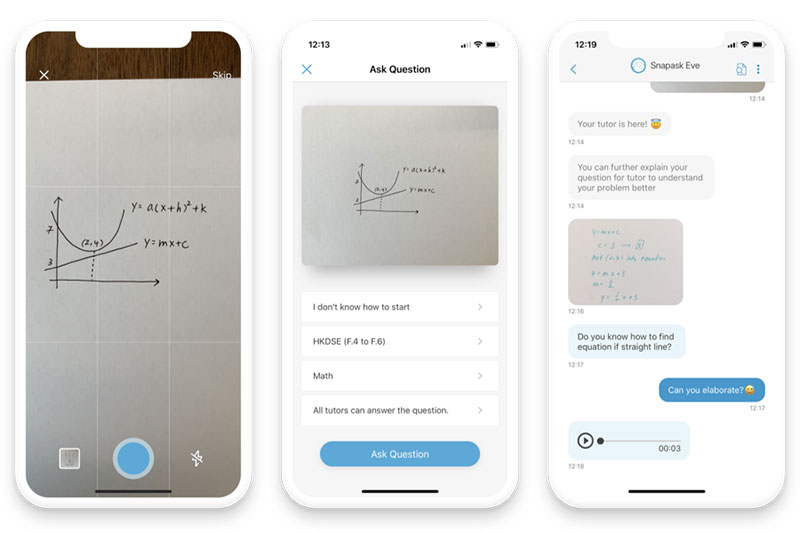On-demand learning app Snapask has seen a recent spike in popularity with the outbreak of COVID-19, as many turn to online education in lieu of classroom learning. Founder Timothy Yu sits down with Hive Life to discuss the future of e-learning.
Founded in 2015 by the young entrepreneur Timothy Yu, Snapask is a mobile app that provides on-demand tutoring by matching students with qualified tutors for interactive, one-on-one virtual tutoring sessions. Known as the ‘Uber for tutoring’, the Hong Kong-based app has raised a total of USD 56.8 million in funding to date, with over 350,000 tutors and 3.2 million students across Hong Kong, Taiwan, Japan, South Korea, Thailand, Malaysia, Singapore and Indonesia. We sat down with Timothy to discuss the future of educational technology, and how Snapask is paving the industry for online-based learning in Hong Kong.

Walk us through your background. How did you wind up founding an education app?
I was raised in Hong Kong and had a pretty typical Asian upbringing. I was studying Math in high school and Finance at university because I thought I had to be a banker, which was a typical journey for most of the friends in my circle. When I was in college in 2008, I ran a tutorial school for a couple of years, wanting to put my passion for education into practice – I was doing a lot of private tutoring on the side, and I was looking to scale it up without having to go door-to-door. The year before graduation, I realised that if we wanted to scale, we could achieve a lot more by bringing education online. So that’s what I did.
What’s the inspiration behind Snapask?
The inspiration for Snapask actually came from when I put my teaching videos on Facebook. Surprisingly, a lot of students came and watched my videos and, after they watched the videos, they would ask me questions or request a follow-up in person. WhatsApp was also starting to become more popular, so a lot of students were quite open to chatting over WhatsApp with their friends and even with their tutors. I found text-only messaging to be quite effective, and it was fast becoming a big trend in how people communicate, so we leveraged this insight and officially launched Snapask in 2015.

How does Snapask work?
There are three main parts of the experience. The first part begins when a student on the platform takes a picture of a question they don’t understand and uploads it onto the platform, which takes about 30 seconds. Then the system matches the most suitable and responsive tutor based on the question asked, the time of asking, as well as the user’s preferences. Students don’t want to ask a question and wait for 30 minutes until someone answers, so we focused on both efficiency and quality. After the matching algorithm identifies the right tutor, the two would go into a chat session, which is the third part: tutors take pictures of the steps that they use to solve the problem and use audio messages to explain it verbally. The whole teaching and learning process lasts about 15 minutes, after which tutors will leave the session and students can leave a rating before moving forward with their learning journey.
How do you guarantee the quality of tutors?
We put a lot of effort into the vetting process to ensure that tutors are eligible to teach. Because a lot of students are underage, we have to make sure no inappropriate behaviour is happening on the platform. We ask tutors for their university transcripts and IDs, and we record all the chat history on our backend. But, just because someone is good in certain subjects doesn’t mean they’re good at teaching. So when they are offering their services and answering questions, the platform takes note of a few things to determine the quality of the session. We look at students’ ratings of the session in terms of the tutors’ attitude and how they are conveying their lessons. We want to make sure that students who have a question will always be matched with the best suitable person.

How has the COVID-19 pandemic disrupted the education industry?
Last year, we acquired about 1.3 million customers from across Asia. Online education is a very obvious trend and many students are open to it, but since the coronavirus outbreak, it’s been accelerating very quickly – out of the 1.3 million users, over 30% joined within the last 3 months, so you can see a very big increase. I think a lot of it is because students have no other options – they cannot go for tutorials, but exams are still happening. Asia has a really exam-driven culture and without school, without tutorial centres, students have to rely on other resources that can only be online.
Will this trend in education continue?
I think this trend will still exist even after the COVID-19 epidemic because people have gotten used to the convenience and, once they try it, it’ll be really hard for them to go back. We can see that students on Snapask have increased their usage: the number of questions asked every month has increased, and users who join are staying on for much longer. Online education has always been a trend and will continue to grow for a long time – COVID-19 only accelerated it.
What is the future of technology in education in Hong Kong?
I think schools are much more open to adopting the right software and tools to help increase efficiency. An example is how they are doing assessments. A lot of teachers give tests and exams, which often puts a lot of pressure on students. Ultimately, the goal is to understand how students are learning and progressing, so teachers can actually break their tests and exams down into micro-assessments and put them online – a small pop quiz of 3 to 5 questions every day to see if students understand the concepts taught in class would be sufficient. Not only does this take off a lot of pressure for students, but it also decreases the workload for teachers so that they can actually focus on improving their teaching.
In the future, I think that there will be wider adoption of this kind of technology. You can see it everywhere, from food delivery and logistics to transportation and leisure – everything is going online. With just one mobile phone, we can basically complete any task that you have, learning included. I think that’s something very much achievable in the next 5 to 10 years.
Related Articles
EdTech 2020: The Future of Endless Possibilities
Patrick Newell: How Personalised Learning Is The Future of EdTech
TestPlay: This App Uses Gamification to Help You Learn Languages





